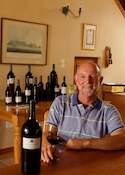A spirit of independence has always marked the way Jeremy Walker has gone about things, despite his chatty nature. As petite wife Mandy says in no uncertain terms: 'Jeremy talks the hind legs off a donkey.'
Vintage 28

When Jeremy admits to an inability to multi-task, Mandy concurs. Quick and efficient, she’s a keen cook with several cookery courses to her name.
'Jeremy usually does things on the braai,' she says. Except when they go camping with fellow Guild member Carl Schultz and his wife Carin, long-time friends. 'Carl does brilliant things with meat on the fire,' says Jeremy generously. 'We do the toasted sarmies - cheese, tomato, and onion sandwiches.'
Back at home, when he's distracted or waylaid - 'stuck in the cellar or down at the beach' - his competent wife has been known to light the fire and take care of the 'sarmies' herself. 'She never burns them,' Jeremy says ruefully.
And so it goes at Grangehurst, their home, and winery on a smallholding on the slopes of the Helderberg Mountain in Stellenbosch, set in a sea of vines, though none of them their own. Jeremy selects specific grapes from the surrounding area and vinifies a soupçon of stylish reds in his small winery behind the house.
The essence of how he does things, mostly by hand, has changed little since his first Grangehurst vintage in 1992, although he has had 'very dependable assistant Gladys Brown' helping him since 2002. He seldom makes more than 5 000 cases, primarily with cabernet sauvignon, merlot, and pinotage - and more recently, Shiraz and Petite Verdot.
These varieties - and some Mourvedre - were planted on Sunset Vineyard, a piece of land in the Greater Simonsberg area on the other side of Stellenbosch, bought in 2000 by Jeremy and business partner Dr. John Hill. However, lying close to Stellenbosch’s urban edge, the theft of trellis wires and poles for construction materials and living vines for firewood is forcing a re-evaluation of farming here.
Grangehurst's start-up cellar was a converted squash court behind the house. Although still part of the winery infrastructure, it was joined by a new production cellar and an underground barrel cellar in time for the 1999 vintage.
Grapes are hand-sorted on an improvised 'sorting table'. 'You won't see any fancy vibrating table or conveyor belt here.' Jeremy's original second-hand, hand-operated Italian basket press, the first piece of winemaking equipment he bought back in the mid-1980s, was upgraded to two automated versions in 1999.
He uses open-top kuipe (fiberglass and stainless steel) to ferment his reds as he always has, balancing on a wooden plank to manually punch down the thick cap of skins with stainless steel paddles at regular intervals during fermentation.
Grangehurst wines are full-bodied but marked by softness and elegance derived from sometimes up to 30 months in some new but mainly older oak barrels. Both a style choice - 'to allow the wines to evolve slowly in barrels without too much oak influence' - and a cost consideration - 'new barrels cost a fortune' - it makes Grangehurst a rare source of well-aged reds.
 Thai beef salad with lemony mint sauce recipe by Jeremy Walker paired with Grangehurst Nikela wine....
Thai beef salad with lemony mint sauce recipe by Jeremy Walker paired with Grangehurst Nikela wine.... Tomato, olive and onion tarte tatin recipe by Jeremy Walker paired with Grangehurst Cape Rose Blend wine....
Tomato, olive and onion tarte tatin recipe by Jeremy Walker paired with Grangehurst Cape Rose Blend wine....